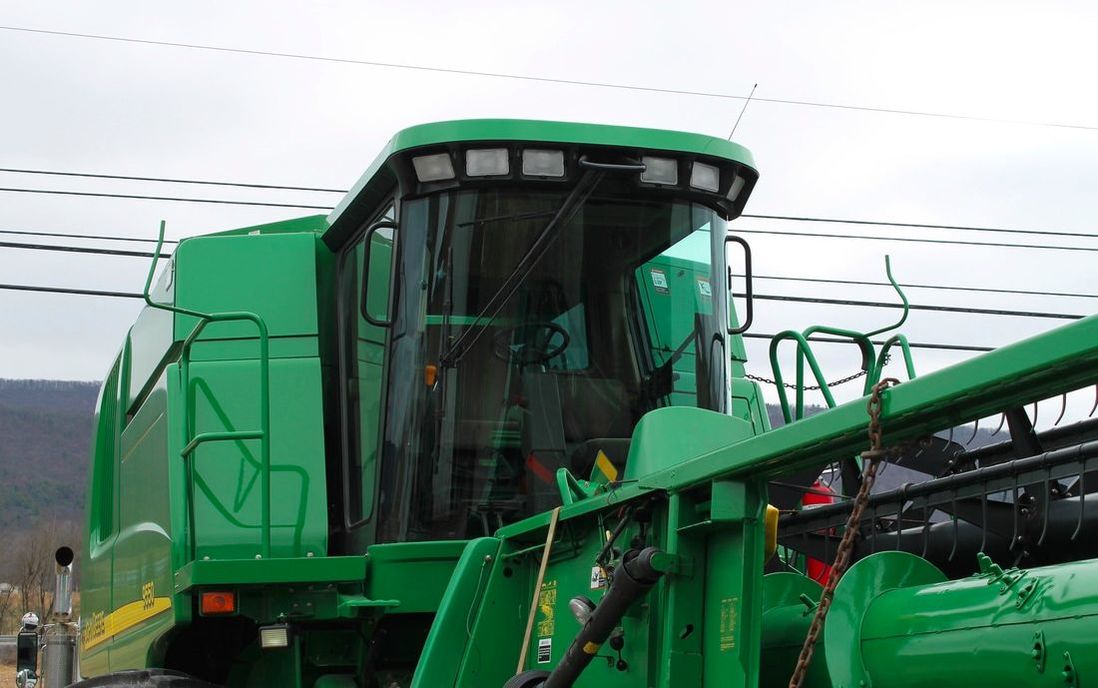Our "new" used combine came on a flatbed hauled all the way from Allentown. In order to deliver the thing, the dealership had to apply for a special permit that listed the exact size specifications of the combine. If the information was at all incorrect, the driver would have had to turn around and return home if law enforcement pulled him over for some reason, not mention pay a hefty fine. You might be wondering how the heck we unloaded it. Well, as you can see above, the tires were somewhat deflated. We actually had to re-inflate the tires first before backing it off the flatbed. But before we did that, you can see a tractor unloader lifting the grain head off of the bed first. What a sight.
So you may also be wondering, what exactly is a combine anyway, besides a big ass piece of machinery that slows me down as I'm trying to drive? To be honest, I didn't know all the details before I looked into it myself! What a good farm hand I am. Here's a bit of a break-down for you:
1. WHAT THE HECK IS IT? A combine is essentially a large piece of agricultural machinery that is used to harvest primarily grain crops, although it can be outfitted to harvest cotton and even bale straw as well. Typically, a combine performs two primary functions: first, it reaps, or cuts, the crop, and then it threshes. Threshing involves separating the kernels of grain from the seed coverings and other rubbish. Back in the day before combines, two separate pieces of machinery were used for grain harvest: one to reap and one to thresh. The first combines developed back in the mid-19th century were so enormous they required at least 20 horses to pull them! I mean, let's be honest, they are still beasts. In fact, combines are some of the most complicated pieces of equipment manufactured today, involving over 17,000 working parts. Just for some perspective, cars only have around 6,000 parts.
2. WHY DOES IT LOOK LIKE A TRANSFORMER? A combine has a large cab in the front with windows and a seat for the driver. Many newer models also have a "buddy" seat for someone to sit and accompany the driver during harvest. The cab is also where all the controls are located and depending on the series, the combine is operated either manually or electronically. Behind the cab is a large tank that houses harvested grain. A long arm extends out from that tank and transfers threshed grain from the combine to a wagon or truck for transport. If you are sitting in the driver's seat looking down, that is the platform, or grain head. If you are harvesting corn, a corn head is used instead of a grain head. You may also have noticed that the combine has two enormous wheels in front and two smaller wheels in back. The larger front wheels are for driving the combine forward and the rear wheels are for steering.
3. HOW DOES THAT THING WORK? A turbo-charged diesel engine powers everything - it not only provides driving power, but also fuels all the other mechanisms in the machine. The grain head, or corn head, that I spoke of does the actual reaping. Let's say you're harvesting wheat with a grain head. There are different parts to a grain head, the most obvious of which is a reel that spins as grains are harvested. As a combine moves through the rows in a wheat field, the reel hovers parallel to the ground and rotates, sweeping grain stalks up and into the machine. A wheat reel actually diverts the stalks into a cutting bar that slices them right below the ripened grain, whereas a corn head strips the ears of corn from their stalks and leaves them flattened in the field. The grain then moves through a series of different parts that eventually separate the kernels of grain from any debris, or "chaff" and are transported into a tank. Finally, the grain leaves the tank through that long arm extension and into a wagon or truck for transport.*
So there you have it! Currently, the 9950 is sitting pretty where the elder sat; it was a pretty snug fit, I might add. The 9550 has a slightly bigger waistline than the 6620 so we were all holding our breath a bit as Mark backed it into the bay of the shed. We knew it was going to be a tight fit, and tight it was. Mark keeps telling me that I will be driving it this year and I'm starting to think he's serious. Maybe I should start looking at the manual...











 RSS Feed
RSS Feed
